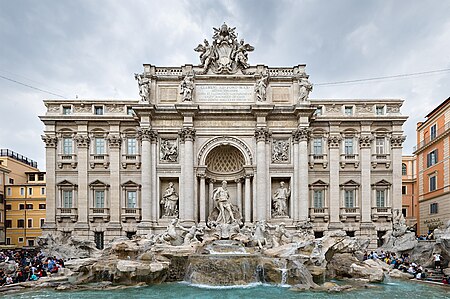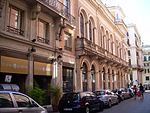Trevi Fountain
1762 establishments in ItalyBaroque architecture in RomeCommons link is defined as the pagenameFountains in RomeHorses in art ... and 6 more
Infrastructure completed in 1762Musical instruments in artRome R. II TreviSculptures in ItalySculptures of godsSeashells in art

The Trevi Fountain (Italian: Fontana di Trevi) is an 18th-century fountain in the Trevi district in Rome, Italy, designed by Italian architect Nicola Salvi and completed by Giuseppe Pannini and several others. Standing 26.3 metres (86 ft) high and 49.15 metres (161.3 ft) wide, it is the largest Baroque fountain in the city and one of the most famous fountains in the world. The fountain has appeared in several films, including Roman Holiday (1953), the eponymous Three Coins in the Fountain (1954), Federico Fellini's classic La Dolce Vita (1960), Sabrina Goes to Rome (1998), and The Lizzie McGuire Movie (2003).
Excerpt from the Wikipedia article Trevi Fountain (License: CC BY-SA 3.0, Authors, Images).Trevi Fountain
Piazza di Trevi, Rome Municipio Roma I
Geographical coordinates (GPS) Address Nearby Places Show on map
Geographical coordinates (GPS)
| Latitude | Longitude |
|---|---|
| N 41.900833333333 ° | E 12.483055555556 ° |
Address
Caffè Roma Gelateria
Piazza di Trevi
00187 Rome, Municipio Roma I
Lazio, Italy
Open on Google Maps










